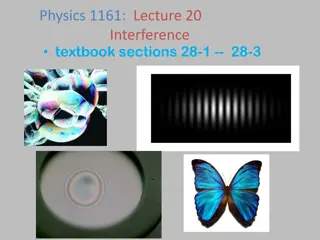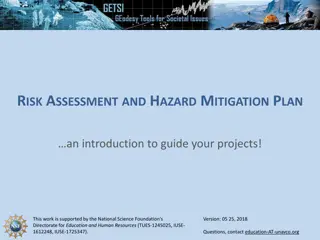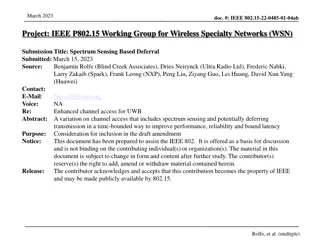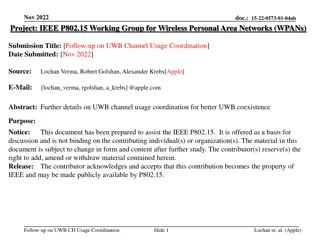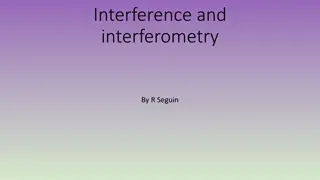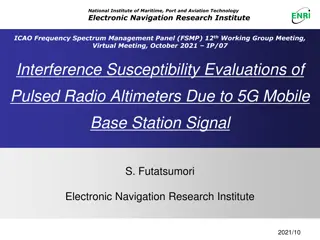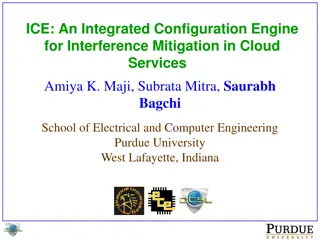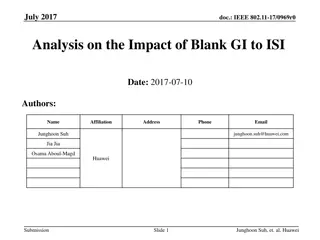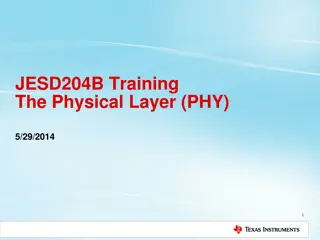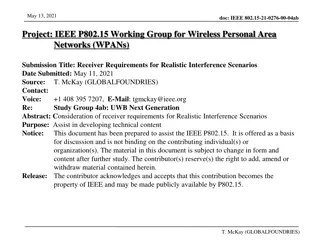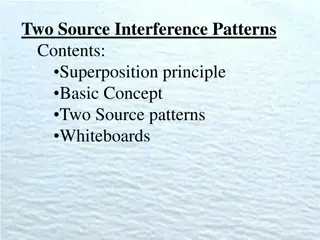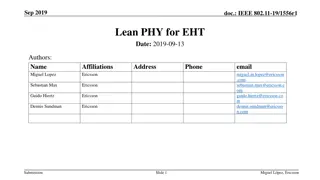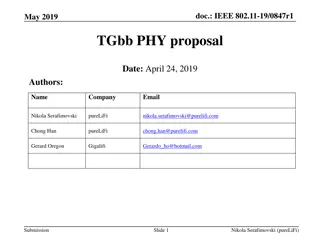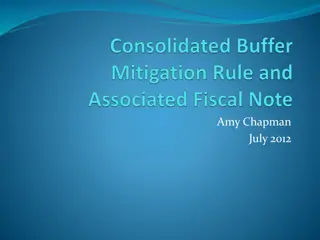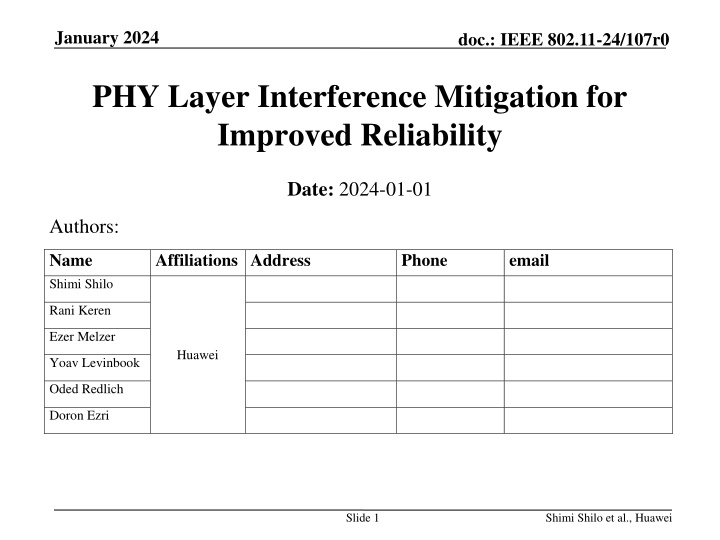
IEEE 802.11-24: PHY Layer Interference Mitigation for Improved Reliability
Explore efficient methods proposed by Shimi Shilo and team from Huawei in January 2024 to enhance reliability in wireless communication systems through interference mitigation. Two distinct approaches, replication in frequency domain and transmitting pilots with data, are discussed along with their advantages and disadvantages. These strategies aim to achieve ultra-high reliability and optimum spectrum utilization by addressing interference challenges.
Download Presentation

Please find below an Image/Link to download the presentation.
The content on the website is provided AS IS for your information and personal use only. It may not be sold, licensed, or shared on other websites without obtaining consent from the author. If you encounter any issues during the download, it is possible that the publisher has removed the file from their server.
You are allowed to download the files provided on this website for personal or commercial use, subject to the condition that they are used lawfully. All files are the property of their respective owners.
The content on the website is provided AS IS for your information and personal use only. It may not be sold, licensed, or shared on other websites without obtaining consent from the author.
E N D
Presentation Transcript
January 2024 doc.: IEEE 802.11-24/107r0 PHY Layer Interference Mitigation for Improved Reliability Date: 2024-01-01 Authors: Name Shimi Shilo Affiliations Address Phone email Rani Keren Ezer Melzer Huawei Yoav Levinbook Oded Redlich Doron Ezri Slide 1 Shimi Shilo et al., Huawei
January 2024 doc.: IEEE 802.11-24/107r0 Introduction In [1, 2] we discussed methods for improving the reliability in TGbn In particular, we suggested two different PHY related approaches for handling interference, using Interference Mitigation (IM) approaches recap on those in the next two slides Improved reliability and more efficient use of the spectrum are important goals of UHR (Ultra-High Reliability) [3] In this contribution we share some new results, address some questions that were raised during the presentation of [2], and provide some explanations about the nature of receiver IM algorithms Slide 2 Shimi Shilo et al., Huawei
January 2024 doc.: IEEE 802.11-24/107r0 Recap: Approach #1 for Mitigating Interference Replicate data in frequency domain as shown in the figure below The receiver can identify if a portion of its spectrum is interfered, and based on this decide which subcarriers (or which replica) to combine (and how to combine) The choice of RU size to use and the replication order (number of replicas) can be opportunistic or based on knowledge at the transmitter side (e.g. on the interference characteristics) Advantages: Simple transmit scheme Significantly more robust to (narrowband) interference Disadvantages: Less beneficial for wideband interference 26-tone 26-tone 4x replication to STA #1 26-tone 26-tone 26-tone 52-tone 2x replication to STA #2 52-tone Slide 3 Shimi Shilo et al., Huawei
January 2024 doc.: IEEE 802.11-24/107r0 Recap: Approach #2 for Mitigating Interference Transmitting known pilots interlaced with the data will allow a (multi- antenna) receiver to track and mitigate potential interfering signals The receiver will apply an interference mitigation (receive beamforming) scheme Various algorithms may be employed Advantages: Can handle interference of any bandwidth Disadvantages: Need extra Rx antennas (beyond N_SS) to cancel the interference Interference Mitigation Pilot Data Slide 4 Shimi Shilo et al., Huawei
January 2024 doc.: IEEE 802.11-24/107r0 Identifying a Random & Sudden Interfering Signal Using either of the two schemes we presented allows a receiver to continuously monitor the received signal and apply interference mitigation (receive beamforming or selecting non-interfered subchannels), such that the receiver reacts immediately to any rising interference In order to demonstrate this, we simulated a simple LOS scenario with a PPDU experiencing an interfering signal which rises in the 12th OFDM symbol We use the 2nd approach with IM pilots interspersed with the data tones MVDR is applied in all tones (after estimating the covariance of the noise and interference in a frequency selective manner) Then we analyzed the resulting equivalent, post-equalization gain in each direction of arrival of the signal, for a single subcarrier (as an example) OFDM symbols Subcarrieres Interference begins Slide 5 Shimi Shilo et al., Huawei
January 2024 doc.: IEEE 802.11-24/107r0 Identifying a Random & Sudden Interfering Signal cont. The figure below shows the effective post-equalization gain computed for each direction of arrival (DoA) We focus on 3 OFDM symbols before and after the interference rises The receiver uses 4 Rx antennas on a ULA, the desired signal arrives at DoA???= 20 whereas the interfering signal arrives at DoA???= 20 , as measured from the ULA boresight We see that the maximum gain is attained at DoA 20 regardless of the interference However, immediately when the interference begins, a deep (~50dB) null is created around the 20 direction Slide 6 Shimi Shilo et al., Huawei
January 2024 doc.: IEEE 802.11-24/107r0 Number of Required IM Pilots (Approach #2) We note that in theory, the number of measurements (i.e. IM pilots) needs to be larger than the number of Rx antennas [4] Otherwise, the resulting sample correlation matrix that estimates the covariance matrix is not invertible It is directly proportional the larger the number of Rx antennas, the more IM pilots are needed So this yields a lower bound on the number of IM pilots (thus CFO pilots cannot be used in many scenarios, e.g. small RUs) Furthermore, all of these considerations should be applied within the coherence bandwidth of the interfering signal; in other words, we need to sample the interference within its coherence bandwidth Also, since we want to mitigate narrowband as well as wideband interference, we need to sample the (possibly narrowband) interference densely enough Given the above theoretical discussion, in the next slides we look at simulation results showing the practical implications Slide 7 Shimi Shilo et al., Huawei
January 2024 doc.: IEEE 802.11-24/107r0 Number of Required IM Pilots (Approach #2) cont. In [2] we showed goodput results comparing various densities (%) of IM pilots In those results, below a certain percentage (e.g. 14%) the goodput dropped abruptly to zero, and not gracefully as expected That was due to the simplistic averaging procedure of IM pilots we used in the simulations (before covariance estimation) same weight for all IM pilots within a fixed-size time-frequency rectangle In order to estimate the covariance of the interference, we computed it over N OFDM symbols and K subcarriers around the tone to be equalized (the red rectangle in the figure shows a schematic example) When the IM pilot density was reduced (below a certain percentage) there weren t enough pilots within the window Slide 8 Data subcarrier Pilot subcarrier x x Decoded QAM Used QAM pilots for decoded QAM OFDM symbols Subcarriers x x x x x x K x x x x x N Shimi Shilo et al., Huawei
January 2024 doc.: IEEE 802.11-24/107r0 Number of Required IM Pilots (Approach #2) cont. To improve the results, we replaced the simple averaging with a weighted averaging within a wider region This way, IM pilots are weighted according to their distance from the data tone to be equalized (i.e. IM pilots closer to the data tone have a bigger impact, whereas the impact of farther IM pilots is smaller) In other words, a wider window may be used such that farther pilots still contribute (albeit with smaller contribution) Using a more flexible filter in both time and frequency significantly improves the results, as shown in the next slide Slide 9 Shimi Shilo et al., Huawei
January 2024 doc.: IEEE 802.11-24/107r0 Number of Required IM Pilots (Approach #2) cont. The figure below depicts the goodput results for a receiver with 4 Rx antennas, 5dB SIR, TGn-D NLOS (both desired and interference, a different channel realization for each), comparing various percentages of IM pilots being used within a 106-tone RU, where the interference covers the entire signal BW As shown, the case of 14% IM pilots, though still worse than all other cases, shows a moderate degradation in performance In this scenario, using ~18% IM pilots is optimal, and the IM receiver is not very sensitive to deviations from this choice Slide 10 Shimi Shilo et al., Huawei
January 2024 doc.: IEEE 802.11-24/107r0 Number of Required IM Pilots (Approach #2) cont. We also evaluated the performance for a receiver with 4 Rx antennas, comparing various percentages of IM pilots being used within a 106-tone RU, with a 2MHz narrowband interference whose location in frequency is randomly chosen per PPDU, with 5dB SIR (computed over the interference bandwidth only) We see that using very few IM pilots (e.g. black/cyan curves) leads to performance degradation In this scenario, using ~16% IM pilots is optimal, and the IM receiver is not very sensitive to deviations from this choice Slide 11 Shimi Shilo et al., Huawei
January 2024 doc.: IEEE 802.11-24/107r0 Handling 20MHz Wi-Fi interference (Approach #1) In [1] and [2] we showed simulation results for approach #1 assuming a 20MHz signal experiencing a narrowband (~2MHz) interference Below we show simulation results for a 40MHz signal experiencing a 20MHz Wi-Fi interfering signal (both experiencing independent TGn-D NLOS channels) rising in a random location in time; we assume MCS 4, single stream and 4Rx/2Tx antennas; as shown, this approach is very robust Slide 12 Shimi Shilo et al., Huawei
January 2024 doc.: IEEE 802.11-24/107r0 Using Midambles as an Alternative (Approach #2) A valid question is whether midambles (e.g. as defined in 11ax) may be used to mitigate interference Midambles were defined in 11ax as a periodic, replicated transmission of the HE-LTF portion, in order to cope with channel variations (Doppler) during the PPDU Midambles were transmitted every 10 or 20 OFDM symbols Considering the original aim of mitigating the random interference which is quite common in the WLAN bands and can start anytime, within any OFDM symbol, as described in [1] we note that separation between midambles will inevitably result in unidentified interference in certain OFDM symbols and therefore in failed codewords For example, in a 242-tone RU using 64QAM and a single stream, there are 1404 coded bits per symbol (N_CBPS) which means ~3/4 of an LDPC codeword So a midamble every 4 OFDM symbols means we may lose up to 3 LDPC codewords and maybe several MPDUs Slide 13 Shimi Shilo et al., Huawei
January 2024 doc.: IEEE 802.11-24/107r0 Using Midambles as an Alternative (Approach #2) cont. In order to evaluate the impact of using midambles as an alternative, we simulated the following: SIR=5dB, MCS 6, 1Tx/4Rx antennas, ~24% IM pilots (so an IM pilot almost every 4th subcarrier in all OFDM symbols) Interference starts randomly anywhere within the PPDU (including preamble) Compared between two receiver schemes: Updating the interference covariance every OFDM symbol Updating the interference covariance every 5th OFDM symbol As shown, there is an error floor when we don t update the interference covariance often entire CWs are lost (error floor is not higher because interference occasionally starts within the preamble) Slide 14 Shimi Shilo et al., Huawei
January 2024 doc.: IEEE 802.11-24/107r0 Conclusions In [1] we discussed how prevalent interference is in the WLAN bands, and how mitigating this interference (or the majority thereof) would lead to significantly better results, in particular lower latency We presented two approaches to mitigate the interference and showed, via simulation results, how we can improve the performance in the presence of random interference In [2] we provided more simulation results and addressed some questions In this contribution we added some explanations about the nature of interference mitigation, some new simulation results, clarifications about previously shared results and also addressed some further questions that were raised during the presentation of [2] Slide 15 Shimi Shilo et al., Huawei
January 2024 doc.: IEEE 802.11-24/107r0 References [1] 11-23-1490r0: Physical Layer Reliability Improvements (Shimi Shilo et al) [2] 11-23-1943r1: Physical Layer Reliability Improvements Follow Up (Shimi Shilo et al) [3] 11-23/0028r6: PAR Discussion (Laurent Cariou) [4] Jian Li, Petre Stoica: Robust Adaptive Beamforming , 2005, Wiley. Slide 16 Shimi Shilo et al., Huawei


